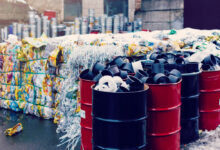I recently ran across a post discussing the wildly popular Greenpeace report about the failures of consumer plastic recycling. The article focused heavily on the idea that at least some plastics are highly prized by recyclers. But the author may have confused some of his readers by briefly touching on post-consumer and post-industrial plastics.
Do you know the difference between the two? It is not a hard difference to understand but failing to grasp it may explain why so many people take an all-or-nothing approach to plastic recycling.
Post-Consumer Plastics
Post-consumer plastics are those plastics that are disposed of by consumers. In nearly every case, people critical of post-consumer plastics zero in on things like plastic food containers, milk jugs, and PET water bottles. But those sorts of things barely scratch the surface.
In the truest sense of the term, post-consumer plastic is any plastic that you would personally dispose of. That includes the plastic case that makes up the bulk of your cell phone. It would include the ballpoint pens you throw in the trash when the ink runs out.
Municipal recycling programs request that local residents put certain types of post-consumer plastics into a bin for curbside collection. But more often than not, curbside collection is limited to plastic food containers. What about all the rest of the post-consumer plastics? Off to the trash they go.
Post-Industrial Plastics
The other side of the coin is post-industrial plastics. Tennessee-based Seraphim Plastics describes these plastics as those that are disposed of by manufacturers, warehouses, and other industrial enterprises.
An injection mold manufacturer produces a ton of plastic waste in the form of cutoffs and plastic purges. That same manufacturer might also have plastic pallets and barrels or buckets that can be recycled. For the record, there is a significant difference between recycling post-industrial plastics and recycling their consumer counterparts.
When Seraphim Plastics picks up a load of plastic cutoffs and purges from an injection mold manufacturer, no sorting is required. The load is clean and pure. All Seraphim needs to do is transport the material back to its facility and run it through a series of grinders that reduce it to regrind. That’s it.
Plastics in No Man’s Land
There are certain types of plastics that occupy that no man’s land between post-consumer and post-industrial classifications. Think airplanes and automobiles. They provide the perfect example. Airplanes are equipped with plastics that are closer to being post-industrial; cars have plastics that are considered closer to post-consumer. Neither type is pure in its classification.
A typical airliner is equipped with tons of plastic parts. When it is finally retired, the plastic is either recycled or sent to the junkyard with the rest of the plane. Are the plastic parts considered post-industrial? Yes, but only because there is no classification for airline plastic.
Likewise, there is no shortage of plastic in your car. If you were to catalog all its plastic parts, you would probably be surprised by the sheer volume. At any rate, what will happen to your car when it finally reaches its end-of-life? It is off to the scrapyard. Are the plastic parts inside it considered consumer plastics? Perhaps, but only because an automobile is considered a consumer good.
Plastic Is Still Just Plastic
The takeaway here is that the post-consumer and post-industrial classifications only exist to differentiate the source of plastic waste. In reality, plastic is still just plastic. It matters little what shape it takes or who disposes of it. Do not be confused by the terms in discussions of plastic manufacturing and recycling.


